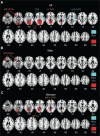The effects of alcohol use severity and polygenic risk on gray matter volumes in young adults
- PMID: 40433172
- PMCID: PMC12106418
- DOI: 10.3389/fpsyt.2025.1560053
The effects of alcohol use severity and polygenic risk on gray matter volumes in young adults
Abstract
Introduction: Genetic factors contribute to alcohol misuse. Chronic alcohol consumption is associated with decreases in gray matter volumes (GMVs) of the brain. However, it remains unclear whether or how genetic risks may alter GMVs independent of the effects of alcohol exposure.
Methods: Here, we employed the Human Connectome Project data of neurotypical adults (n = 995; ages 22-35; 534 women) and, with voxel-based morphometry analysis, computed the GMVs of 166 regions in the automated anatomical atlas 3. Alcohol use behaviors were assessed with the Semi-Structured Assessment for the Genetics of Alcoholism. Alcohol use severity was quantified by the first principal component (PC1) identified of principal component analysis of 15 drinking measures. Polygenic risk scores (PRS) for alcohol dependence were computed for all subjects using the Psychiatric Genomics Consortium study of alcohol dependence as the base sample. With age, sex, race, and total intracranial volume as covariates, we evaluated the relationships of regional GMVs with PC1 and PRS together in a linear regression.
Results: PC1 was negatively correlated with GMVs of right insula and Heschl's gyrus, and PRS was positively correlated with GMVs of left posterior orbitofrontal cortex, bilateral intralaminar nuclei of the thalamus and lingual gyri.
Discussion: These findings suggest distinct volumetric neural markers of drinking severity and genetic risks of alcohol misuse. Notably, in contrast to volumetric reduction, the genetic risks of dependent drinking may involve larger regional volumes in the reward, emotion, and saliency circuits.
Keywords: HCP; VBM; alcohol dependence; polygenic risk score; thalamus.
Copyright © 2025 Chen, Li, Luo, Li, Ide and Li.
Conflict of interest statement
The authors declare that the research was conducted in the absence of any commercial or financial relationships that could be construed as a potential conflict of interest.
Figures

Update of
-
The effects of alcohol use severity and polygenic risk on gray matter volumes in young adults.medRxiv [Preprint]. 2025 Jan 20:2025.01.20.25320842. doi: 10.1101/2025.01.20.25320842. medRxiv. 2025. Update in: Front Psychiatry. 2025 May 13;16:1560053. doi: 10.3389/fpsyt.2025.1560053. PMID: 39974144 Free PMC article. Updated. Preprint.
References
LinkOut - more resources
Full Text Sources
Research Materials
Miscellaneous

